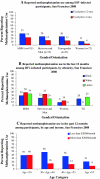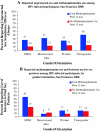Methamphetamine use, transmission risk behavior and internet use among HIV-infected patients in medical care, San Francisco, 2008
- PMID: 21190073
- PMCID: PMC3274665
- DOI: 10.1007/s10461-010-9869-7
Methamphetamine use, transmission risk behavior and internet use among HIV-infected patients in medical care, San Francisco, 2008
Abstract
Methamphetamine use is associated with adverse health outcomes and HIV incidence. Few studies have assessed methamphetamine use, sexual behavior and Internet use among HIV-infected patients. Surveys were administered to a sample of HIV-infected patients seeking medical care in a San Francisco county hospital and university-based clinic. In 2008, 35% of homosexual participants, 26% of heterosexual participants and 11% of female participants reported methamphetamine use in the past year. Of participants, 29% reported using the Internet to find sex partners; Internet-users versus non-Internet-users reported a higher median number of sex partners in 6 months (4 vs. 1), were more likely to report unprotected sex (32 vs. 10%), and higher rates of methamphetamine use in the past 12 months (48 vs. 24%). Given the association among methamphetamine use, increased sex partners and Internet use, the Internet may present a new and effective medium for interventions to reduce methamphetamine-associated sexual risk behavior.
Figures


References
-
- Substance Abuse and Mental Health Services Administration (SAMHSA). Methamphetamine use 2007. The National Survey on Drug Use and Health (NSDUH) report; 2007.
-
- Colfax G, Coates TJ, Husnik MJ, Huang Y, Buchbinder S, Koblin B, et al. Longitudinal patterns of methamphetamine, popper (amyl nitrite), and cocaine use and high-risk sexual behavior among a cohort of San Francisco men who have sex with men. J Urban Health. 2005;82(1 Suppl 1):i62–i70. - PMC - PubMed

